Vegetative petunia Starry sky with amazing looking flowers
The Starry sky petunia hybrid appeared on the market relatively recently, but quickly won the love of flower growers. The plant is characterized by high decorativeness due to the beautiful flowers of dark purple color with a scattering of white specks. Visually, the drawing resembles space. We will tell you in detail about the features of this plant and how it is grown and propagated.
The content of the article
The origin and description of petunia Starry sky
For the first time, botanists learned about the existence of petunia in the 18th century.... Since then, the triumphant procession of the plant has begun around the world. Now cultural hybrids adorn gazebos, balconies, summer cottages and greenhouses.
Petunia Starry sky, Starry night or Night sky - a hybrid developed by German engineers Selecta Klemm GmbH & Co. KG in 2015.

In the photo - petunia Starry sky.
Hybrid characteristics
Petunia The Starry Sky from the Solanaceae family is highly decorative and blooms with dark purple flowers in a white speck... The drawing resembles the night sky, strewn with stars, hence the name of the cultivar. Petunia loves diffused light. In such conditions, the flowers retain an intense purple color. The more light, the lighter the petals. To maintain color contrast, it is recommended to maintain a significant difference between day and night air temperature.
Petunia Night sky is characterized by excellent branching, early flowering... A distinctive feature of the hybrid is the continuous formation of buds, so flowering lasts 2-5 months, from spring to autumn. The maximum length of the bushes is 1 m in length, so they are usually planted in hanging baskets or pots. Each flower has 5 wide and rounded petals.
The leaf blade is bright green, velvety... There is a lot of green mass, so the bush visually resembles a volumetric ball.
The optimum temperature for the culture is + 10 ... + 37 ° C... This wide range contributes to the formation of white dots on the petals.
Reference. The Night Sky hybrid won the prestigious 2015 European Fleurostar International Exhibition. The jury gave him a high mark for his appearance, unpretentious care and ability to grow in regions with different climates.
Advantages and disadvantages
Benefits of a cultivar:
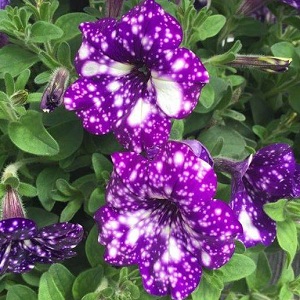 attractive appearance and cosmic pattern on flowers;
attractive appearance and cosmic pattern on flowers;- fast branching and rooting of cuttings;
- early and long flowering;
- unpretentious care;
- resistance to high air temperature;
- neat bush.
disadvantages:
- there is no way to grow by seed, only by cuttings;
- predisposition to powdery mildew and gray rot.
Interesting on the site:
Ornamental cabbage: features of the culture and description of varieties
Growing technology
Planting petunias Starry sky is possible only with the help of cuttings... The manufacturer did not provide for the possibility of sowing with seeds. You can buy cuttings in tablets from gardeners who grow crops, or in gardening stores, at fairs and exhibitions.
For planting, a soil mixture is pre-prepared:
- 2 parts of peat;
- 2 pieces of turf;
- 2 pieces of leafy land;
- 2 parts of humus;
- 1 part sand.
The soil is mixed in a large container and poured with a strong solution of potassium permanganate for disinfection.
The procedure for planting cuttings is simple, they quickly take root and grow... Cuttings are planted directly in peat tablets in hanging pots or pots filled with soil. The containers are placed in partial shade for 2 weeks for rooting.
The petunia bush is left for further development in a pots or transferred to open ground:
- Landing is performed in the afternoon on a cloudy day.
- Saplings with 5-7 leaves are transplanted together with an earthen clod into holes 10 × 10 cm in size with an interval of 25-30 cm.
- The soil is compacted with a palm, mulched with peat or humus and watered with warm water.
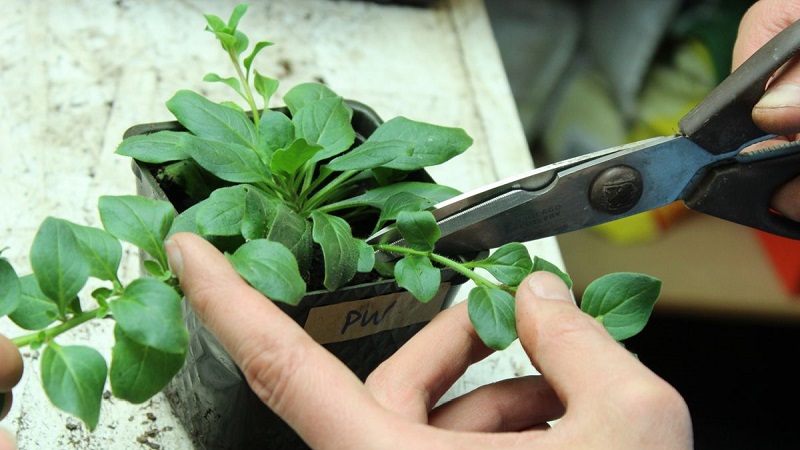
Optimal conditions and further care
Optimal daylight hours for the good development of petunia Knight sky - 11-13 hours. With a lack of sunlight, the plant is supplemented with a phytolamp.
Daytime air temperature - up to + 35 ... + 38 ° С, night - not lower than + 10 ° С... The minimum difference between day and night temperatures required for the formation of the correct pattern on the flowers is 10-15 ° C.
After transplanting petunias to a permanent place, regular watering is performed - 1 time in 3 days under the root, without getting on flowers and leaves. The moisture level of the soil is checked with a finger: the phalanx is immersed 2-3 cm deep, if it is dry, water is added.
The plant is fertilized with phosphorus, potassium and nitrogen no more than 3 times a month:
- For the first feeding, superphosphate is used (25 g per 10 l of water). Phosphorus is essential for the formation of a strong rhizome.
- For the second feeding, after 14-20 days, use complex formulations "Agricola", "Ideal" (20 g per 10 liters). Top dressing is applied simultaneously with watering 1 time in 10-12 days.
- In the period of bud formation at the end of May, fertilizer with potassium "Kemira Lux" (25 g per 10 l) is applied.
- During the flowering period, petunia is fertilized once every 2 weeks with complex additives: Etisso, "Master", "Garden of Miracles", "Uniflor Bud".
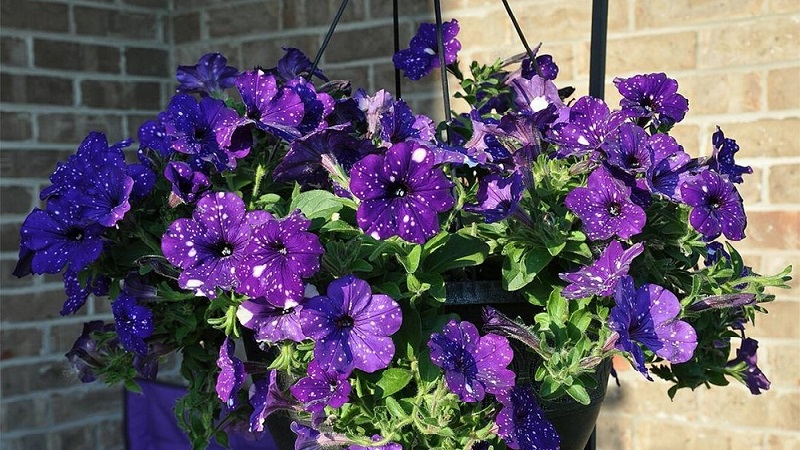
Experienced gardeners recommend feeding every 3 days simultaneously with watering, reducing the concentration by half. This has a beneficial effect on the condition of the bush and maintains abundant flowering.
Attention!When applying dressings, it is important to observe the measure. Otherwise, the risk of developing putrefactive and fungal infections increases.
To form a neat bush, pruning is performed... Long branches become thinner, and flowers grow small, pale in color. Cut cuttings can be re-rooted in the ground. Dry and lethargic flowers are cut with sharp scissors.
Possible problems, diseases, pests
Problems with growing petunias Starry Night are associated with violation of the rules of care.
For the prevention of fungal infections or at the first signs of infection, the leaves are treated with copper-containing preparations, for example, copper sulfate.
Reference.With an excess of moisture and sunlight, the leaves turn yellow, the buds and flowers wither and fall off, with a deficit, the leaves wrinkle and darken.
The main pests of petunias are spider mites, aphids and thrips. A close inspection of the plant will help to identify the pest.:
- Spider mite likes to settle in petunia buds and leaves. Small white dots and sticky cobweb entwining are sure signs of damage. To kill ticks, use the Apollo and Demitan acaricides. The frequency of spraying is 3 times a day. Dandelion infusion - 250 ml per 10 liters of water will also help to get rid of spider mites. The frequency of processing is three times, once every 8-10 days. To prepare the infusion, take 500 g of dandelion flowers and leaves, pour 5 liters of boiling water and leave for 24 hours.
- Aphids infect buds and flowers... The pest feeds on plant juices, which makes the petunia wither and dry. Drops of honeydew appear on the stems and leaves, which serves as a breeding ground for fungal infections. Aphids carry viruses that are difficult and sometimes impossible to combat. To destroy aphids, use a soap-tobacco infusion (50 g of shavings of laundry soap and 100 tobacco dust per 1 liter of water) or a solution of "Fufanon" (1 ml per 1 liter).
- Thrips settle on the front and back of the leaves... Dry white stripes are visible on the surface.Flowers and buds become deformed and wither. Among insecticides, Aktara and Confidor have proven themselves well. The frequency of processing is 1 time in 7 days for a month.
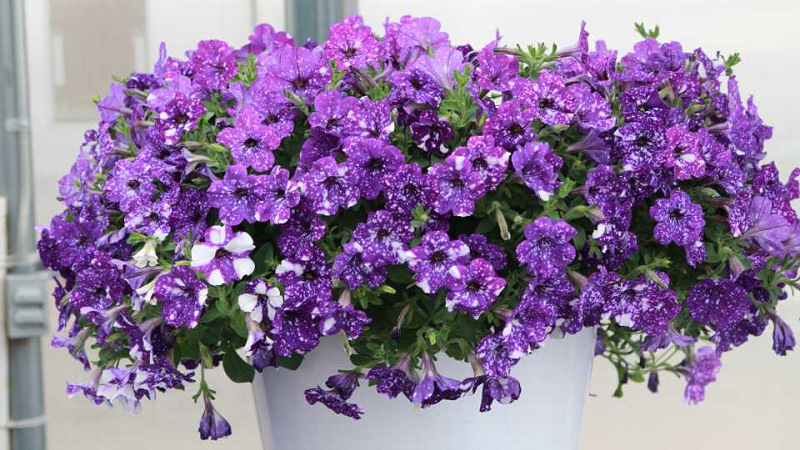
Of the diseases, petunias are especially dangerous powdery mildew and gray mold:
- Powdery mildew is indicated white spots and pubescent bloom on foliage. The fungal infection spreads from the bottom up and gradually spreads to buds and flowers. The leaves curl upward and dry. The affected parts are removed to stop the spread of the disease. The bushes are sprayed with infusion of garlic (250 ml per 10 l) or mustard (2 tablespoons per 10 l of warm water).
- Gray rot - a fungal infection, in which the leaves become covered with a sticky, pubescent gray bloom, brown spots, and then dry out. Without treatment, the plant dies in 2-3 days. Dry and sluggish leaves and buds are removed, feeding is stopped. For treatment use the drug "Trichodermin".
Read also:
Reproduction methods
Petunia The night sky reproduces exclusively in a vegetative way... To do this, break off a 10 cm long stalk and place it in 100 ml of water. After the appearance of the roots, after 10-14 days, the petiole is planted in a pot with a peat substrate with a volume of 200 ml. The plant feeds on the leaf, since the root system is not yet sufficiently formed.
The cutting is sprayed with water at room temperature twice a day. and fed once with "Kornevin" (25 g per 10 l of water).
After 14 days, a full-fledged rhizome is formed and builds up mass throughout the month. A developed small bush is transplanted into a hanging container with a volume of 2-2.5 liters.
Useful tips from experienced florists
For the entire period of the existence of petunia growers have accumulated rich experience in its cultivation and share it with beginners:
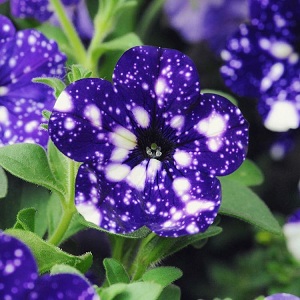 Bushes watered strictly at the rootwithout falling on foliage and flowers. Spraying from a spray bottle is carried out in the evening so that the plant does not get sunburn.
Bushes watered strictly at the rootwithout falling on foliage and flowers. Spraying from a spray bottle is carried out in the evening so that the plant does not get sunburn.- Waterlogging of the soil threatens the development of putrefactive processes.
- Long branches of petunia pinchto form a compact shrub and provide adequate flower and bud nutrition.
- To reduce the amount of feeding, the soil is mixed with the hydrogel. It absorbs and retains nutrients, which are then absorbed by the plant.
- Hybrid Starry sky does not lay seed pods and propagates exclusively by cuttings. If you see bags of seeds of this cultivar on sale, be aware that this is a fake.
- Dry and lethargic flowers do not leave on the bush, but cut with sharp scissors.
- At the end of the flowering period shoots are cut to half to stimulate branching and flower buds.
- To save petunia for next year, by the onset of the first frost, the plants are transferred to individual pots and placed in a warm room. Dry and weak branches are cut, leaving 10 cm. Petunia successfully winters at a temperature of + 10 ... + 15 ° С and watering frequency 2 times a month.
Conclusion
The name of the petunia Night sky speaks for itself. In these amazingly beautiful flowers, you can see the starry sky on a clear night. On a dark purple background, white spots of various sizes are scattered. The color intensity depends on the air temperature and lighting. In partial shade, the flowers retain a rich shade longer, and in bright daylight, more white large spots appear.
The cultivar is grown in a vegetative way using cuttings. Ready-made seedlings are purchased in specialized stores or harvested independently from existing bushes. It is easy to care for petunia: it is enough to maintain an optimal level of humidity, apply supportive fertilizing, cut long branches and carry out a preventive examination.